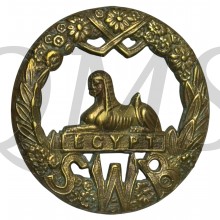Cap badge South Wales Borderers
The 1st Battalion, as part of the 10th Indian Infantry Division, was sent to Iraq to quell a German-inspired uprising in Iraq in November 1941.[23] The battalion saw subsequent service in Iran. The battalion sustained enormous casualties in Libya near Tobruk when they lost around 500 officers and men captured or killed during a general retreat. The battalion found itself cut off when the German forces outflanked them, the Commanding Officer, Lt. Col. F.R.G. Matthews, decided to attempt to escape around the enemy and break through to British lines. It turned into a disaster with only four officers and around one hundred men reaching Sollum.[23] To the surprise of the survivors the battalion was ordered to disband in Cyprus and the remnants of the battalion were transferred, with the exception of a small cadre that returned to the United Kingdom, to the 1st Battalion of the King's Own Royal Regiment (Lancaster). A few months later the battalion was re-formed from the cadre and the 4th Battalion, Monmouthshire Regiment.
Upon the outbreak of the Second World War in September 1939, the 2nd Battalion was serving in Derry, Northern Ireland, under command of Northern Ireland District, having been there since December 1936. In December 1939 the battalion left Northern Ireland and was sent to join the 148th Infantry Brigade of the 49th (West Riding) Infantry Division, a Territorial formation. In April 1940 the battalion was again transferred to the newly created 24th Guards Brigade (Rupertforce), and took part in the Norwegian Campaign, and were among the first British troops to see action against the German Army in the Second World War.[26] The campaign failed and the brigade had to be evacuated. Casualties in the battalion, however, had been remarkably light, with only 13 wounded and 6 killed and two DCMs had been awarded.[27]
The 6th Battalion, South Wales Borders served in the Burma Campaign with the 72nd Infantry Brigade, 36th British Infantry Division, previously a division of the British Indian Armybefore being redesignated the 36th British Division




